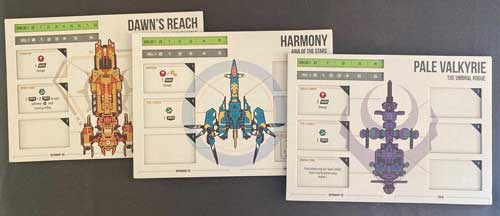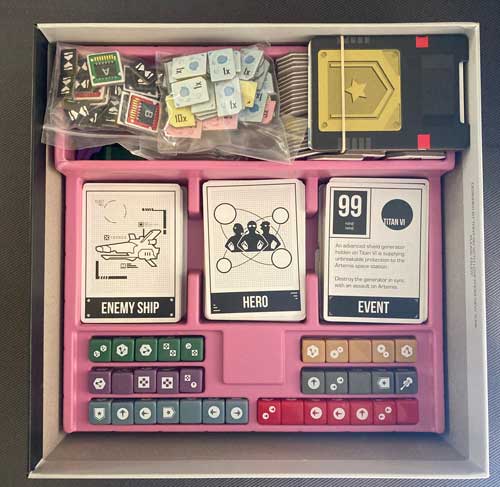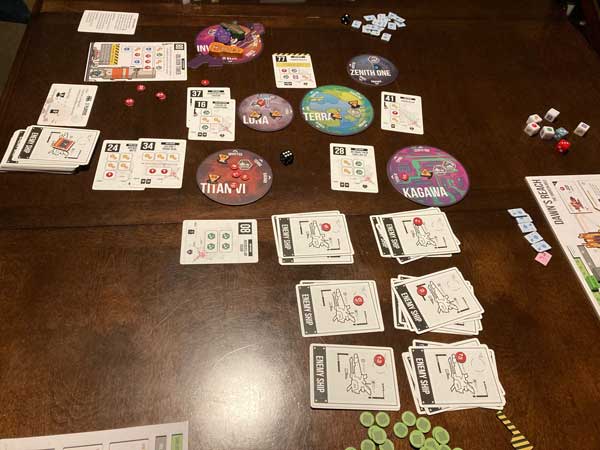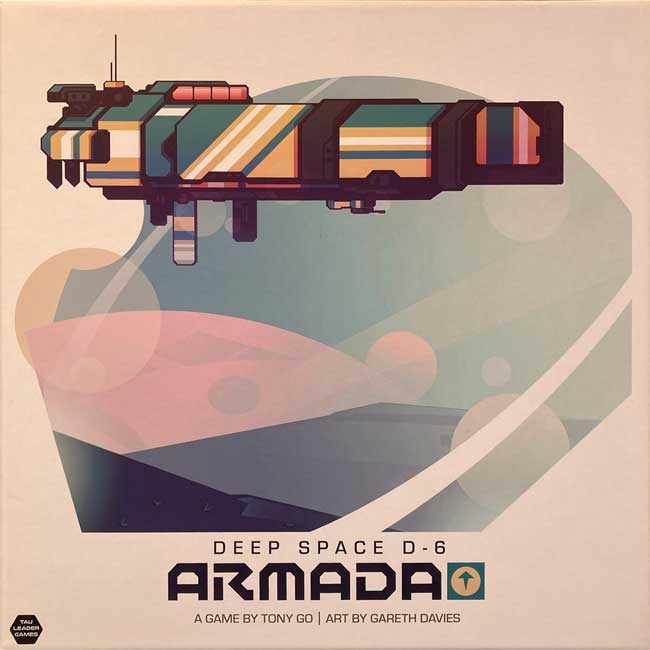Deep Space D6 Armada is a game published by Tau Leader Games. The premise of the game is for players to take on the role of rebel starship commanders fighting against an evil regime known as The Federation. Players, working together, travel through the galaxy to defend enemy ships and protect the planets. The final encounter is triggered once players have collected two data tokens and players win by defeating the final encounter or fail together.*
*The number of data tokens required is based on the "Rules Modifications" pdf available on the Tau Leader Games website. In the original rule book, the final encounter was not triggered until four data tokens were collected. I specify the pdf document because there is a different update in an FAQ section.
This post is broken into the following 3 sections, feel free to jump directly to one:
- General summary - consisting of information about overall enjoyment, theme, replayability, and upgrades
- Complexity - consisting of information about the rulebook, setup, player turns, and overall learning curve
- Player turns - consisting of game type, game flow, rule you are likely to miss, and favorite aspect
General Summary
Number of players we had: 3
Our play time (not including setup): 2 hours 40 minutes
Table size needed: Medium/Large (5' or greater)
Overall enjoyment

Overall our group really enjoys playing this game though there are several things about the game play we think could be better. Deep Space D6 Armada is a cooperative game, which we generally like, and several of us love the space theme. We like all the dice rolls, the very detailed dual-layered ship boards, the unique ship modules and how well they fit into the slots on the starships, the additional crew members, and working together to fight enemy ships.
This game does not include a main game board, but instead has planet tiles that you arrange on your table. Each player has a unique starship board with slots to upgrade their ship along with a matching starship token and dice to represent your starting/basic crew members.
In the game, players move between planets to answer distress beacons, which can earn them credits or data tokens. Credits can be used to upgrade starships or add crew members. Players are also forced to combat enemy ships when they are located on a planet with their starship which can also earn credits, but may weaken their ship if they take damage.
There was clearly a lot of time taken in designing the starship boards, the 34 additional crew/hero cards and the corresponding crew dice, the 55 enemy ship cards and the 30 threat detected cards. By contrast, I think the rules could have been thought out slightly better as in its original state, the game went on far too long and the challenge arc of the game begins too challenging and ends too easily. Luckily, there have been some updates to the rules which helps, but we still felt there were some ways the game could play out better.
Which leads me to the thing we found frustrating about this game: the game end trigger. While the updated rules definitely make game play better, the one thing that still needs some finesse is the end of game trigger. The final encounter is triggered by acquiring data tokens and players either win or lose the final encounter which ends the game.
Data tokens are acquired by defeating Away Missions, which are revealed as a result of adding distress beacons at the end of each round. Once revealed, one or more players must travel to the planet with the data token and meet the requirements of the Away Mission, by rolling dice, to claim the data token.
The number of distress beacons revealed each round corresponds with the number of players. For us, per the rules for our three player game, we revealed two distress beacon and two threats at the end of each round. Unfortunately, though there are a total of 8 data tokens that can be revealed, there are a total of 42 distress beacons that do not include data tokens and distress beacons are drawn randomly out of a bag.
If two data tokens are drawn early, players can simply wait to acquire them and use the time to fortify their ships or add crew to increase their chances of winning the final encounter. However, if data tokens are not drawn for a long time, which has happened to us, the game goes on way too long.
So while the game play is fun, best case scenario players can ensure a win at the end by prolonging the game, and worst case scenario, the game simply lasts too long because following the current rules, there is no way to ensure players will draw distress beacons that correspond with data tokens within a certain number of rounds.
Theme

The theme of Deep Space D6 Armada is space. Every component in the game relates to space in some way. The starship boards and corresponding tokens are colorful and completely unique. Additional hero crew members have different abilities and each of their die have symbols on three - six sides of their die, all of which are unique.

Replayability

There are several things that increase the replayability of this game, including:
- There are 88 station modules that can be used to upgrade starships.
- There are 34 additional heroes that can be added as crew members. These heroes each have their own image, description and special ability in addition to their own die whose sides are completely unique to them.
- There are six different final encounters.
- There are six starships players can choose from, each with its own starting abilities.
- Enemy ships and event cards related to distress beacons are placed by random.
Upgrades
I am not aware of any upgrades for this game, but it comes standard with a custom insert for all of the components. The ship boards and planets stack nicely on top of the insert shown below. Also, it is worth mentioning that this is a physically heavy game, with lots of components and dice.
Lastly, I want to share that the publisher has taken the time to update the rules based on feedback, added this and a sheet of corrected language for some station modules and a hero card in pdf format on their website for easy printing for those who have the game.

Complexity
Rule book
The rule book for this game is fairly long. In general, the rule book has decent explanations of game play and images to help you identify all of the components. Because the rule book is so extensive, we did find some things we really liked and some things that were frustrating.
What we liked...
- There are indexes describing every player starships, station module upgrade, additional crew, and enemy ship at the end of the rule book. There are also accompanying images for most of these and at times these provide a more detailed description of an item which helps game play.
- The back page of the rule book has an overview of game play and some of the often used icons.
- There is a table of contents at the beginning of the rule book.
What we didn't like...
- Some parts of game play are broken apart, making it harder to keep track of the rules. For instance, combat rules are broken between one-player combat and teaming up (combat with multiple players). We found this made combat rules slightly harder to follow and were not sure why this was done when it is a cooperative game.
- Even though there is a table of contents, the headings are vague and it was often still challenging to find the information I was looking for when I needed it.
- Keeping track of the rules that have been modified since the game was released can be challenging.
Setup
Setting this game up takes about 15-20 minutes. This is not a very complex process, but there are lots of components, decks of cards and player boards that follow a series of steps. Once everything needed to play is ready, draw the appropriate amount of distress beacons and you are ready to begin.
Turns
As a cooperative game, some portions of player turns are taken simultaneously so turns feel faster. Each round players begin by taking up to two actions. These actions include: traveling to a new planet, repairing hull damage, trading items with another player in the same location, buying and upgrading ship modules or configuring them, or hiring crew. We often do these at the same time as there is no need to wait on another player to pick a crew member for example.
Once all actions have been taken, players must combat any enemy ships at their location and then they can optionally attempt to complete an Away Mission. To complete the round, players draw new distress beacons which correspond with an event card, as well as drawing the appropriate number of threat cards and deploying enemy ships to the location listed on the threat card.

Overall learning curve
The overall learning curve of this game is medium to high, not because the game play is overly complex, but because it can be hard to keep track of all of the rules and the nuances to them. Player actions and game play is not difficult, but the game can feel very busy with new distress beacons triggering event cards and new threat cards triggering additional enemy ships at the end of every round. However, this tracks with the theme, and as long as the game does not go on too long (data tokens), trying to keep planets from being overwhelmed is half the fun.

Player Turns
Play type
Deep Space D6 Armada is a cooperative, dice rolling combat game with a strong space theme. Players move from planet to planet fighting enemy ships and taking on missions in hopes of acquiring data tokens that will trigger the final encounter.
Game flow
The flow of this game is mostly fluid as big portions of each round are carried out simultaneously. Player actions, aside from ship upgrades and adding crew, are quick. When players are upgrading or adding crew, it often makes sense to discuss which upgrades will have the greatest impact on game play.
Combat can be carried out by a single player, in which case another player is rolling for the enemy ships, or with multiple players as team combat, in which case multiple players are rolling dice to fight enemy ships at the same time. Either way, combat goes by quickly as multiple players are always involved. Lastly, players can attempt Away Missions on their own, or together, simultaneously.
Where the game can get a little clunky is in randomly drawing distress beacons, which triggers the event card of the same number. The distress beacon is placed on the planet listed on the event card and the event card is placed nearby. Then threat cards are drawn which trigger creating new fleets of enemy ships or adding ships to existing fleets on the planet listed on the threat card. The process of deploying distress beacons and threat cards each round can feel redundant when the game goes too long. This is why having a guarantee data tokens would be revealed within a certain number of rounds would be ideal.
NOTE: In the beginning we dropped the number of threat cards drawn at the end of each round from two to one. With three players, the games were getting really long and we were playing until we had four data tokens! Now that we are only playing for two data tokens, we draw both threat cards.
Rule you are likely to forget/miss
It is hard to say which rule you would be likely to forget or miss. We have played this game over a dozen times and there are still times we miss something. I think this game would be served well to have a more comprehensive player aide.
Some of the rules we have forgotten or missed are:
- When a crew member is retrieved from the Infirmary, they are not available until the next round.
- When in team combat, only the frontline player takes damage (unless the enemy ship delivers an area attack).
- Players can only attempt one Away Mission each round. If they participate as a team against an Away Mission, that counts as the one attempt for both players.
- All offline tokens added to station/ship modules are removed at the end of combat.
- Unless you have a station/ship module that allows you to damage multiple enemy ships, a weapon can only target one enemy ship at a time.
- When combat ends in a victory, reclaim any crew in the infirmary and restore shields to 100%.
Favorite aspect
The thing we like most about this game is all the detail and care taken in creating the starships, the additional heroic crew member cards which have a little information about them, a special ability and a unique corresponding die, and the station modules players can add to their ships. This is a fun game that would be good for people who like cooperative board games with combat, space-themed games, or dice rolling.
While we do think the rules needed a little more time to get just right, we still always enjoy playing this game. In the future, I think I will work on a player aide that covers combat cleanup and a few other items that address places we have forgotten or misunderstood the rules to help us enjoy this game more.


